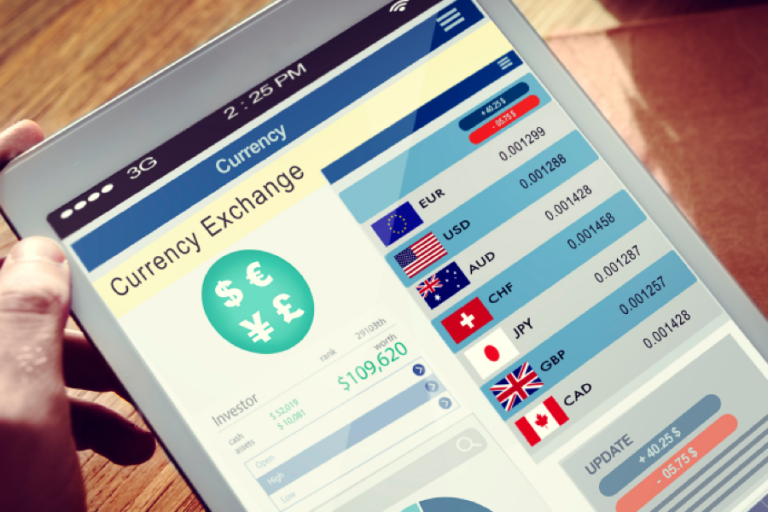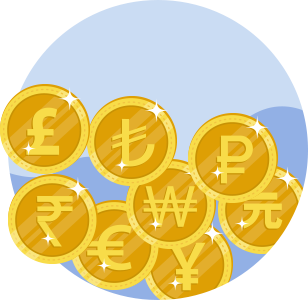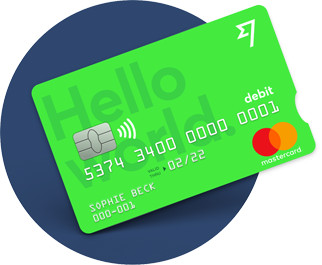The Best Foreign Currency Accounts in Australia in 2024
Foreign Currency Accounts can be an incredibly useful tool or a black hole of fees and charges. Find out the basics of how foreign currency accounts work and they're best (and worst) features.

What is a Foreign Currency Account?
Foreign currency accounts or multi currency accounts from your bank have a lot in common with your everyday transactional banking account. You can use them to receive money or pay money.
Most accounts also accrue dismal interest, just like most everyday banking accounts. The biggest difference is that the account might hold other currencies, such as US dollars.
You also have the ability to bill in a foreign currency, which makes dealing with overseas customers much easier. Plus, it allows you to hold the foreign currency in a local account that you can control.
Unfortunately, foreign currency accounts can be subject to multiple international fees – a reality you should consider before you decide to open an account with your bank.

Pros and cons of using foreign currency accounts
- Save money on currency conversion fees
- Hold multiple currencies in a single account
- Ability to open local accounts in local currencies
- International businesses can bill in foreign currency
- Buy currency ahead of time to avoid exchange rate moves
- High minimum balances
- Bank fees on these accounts are high, compared to a regular local Australian transaction account
- Varied bank fees makes it difficult to compare accounts
- Can be difficult to open an account
When should I use foreign currency accounts?
If your business is just starting to send money overseas or receive money in other currencies, foreign currency accounts are worth looking at. However they may not be cost-effective given the fees that come with it. There is no magic number at which point they become useful but if you're receiving more than $500,000 in another currency, we think it's a worthy option.
There can also be benefits for international travellers. If you spend cash in local currency overseas from your foreign currency account, you can increase your savings by again, avoiding exchange rate fees. However some banks don't even offer this service, or they charge ATM fees and transaction costs that are ridiculously high.
Wise Multi-Currency Account
Alternatively you could try a money transfer service like Wise that also offers a multi currency account in Australia, called the Borderless Account.
At first glance, it's easier to set-up, receive and send foreign currency. The fee structure is also better than any of the other foreign currency accounts listed in this review.
The thing that makes it different to every other foreign currency account, is that it allows you to up a local bank account in AUD, GBP, EUR, NZD or USD. That means if you open up a USD account, you’ll have your own ABA and account number (think BSB and account number).
It’s a big deal. Why?
Having your own local bank account makes it significantly easier, faster and cheaper to receive money.
Wise now offer a debit card associated with the account for your international travel. This means you can spend like a local, too.

Revolut also offers multi-currency accounts that have been available to all business and personal customers in the US since March 2020.
3 different personal Revolut account plans are available. The Standard plan is free from monthly fees. There’s also the option to upgrade to Premium for USD9.99/month or Metal for USD16.99/month. Paid plans allow you to access additional features and benefits including fee free ATM withdrawals, preferential customer service, premium physical cards and disposable virtual cards. Revolut business accounts, and junior accounts for children are also available.
With Revolut you can hold 28 currencies in the same account and manage your money using an app. Revolut users can send money internationally using the mid-market exchange rate, with fees payable at weekends, on certain currencies. If the standard plan customers send over USD1.000 each month a month, there's a 0.5% fee for anything above. Sending between Revolut accounts is instant.
How do foreign currency accounts work?
There are three main steps to setting up a foreign or multi currency account, which we have outlined below. You can also watch our video tutorial (see above) for a complete guide.
![]()
Step 1: Register
Register your personal or business details through your bank. You will choose the type of account you need, your details and the currencies you'll transfer. Once you provide some ID, your bank will let you know when your account is ready.
![]()
Step 2: Transfer
Once you have a quote for your transfer, you will go ahead and fill in the details of the person you're sending the money to. Or you can give the person your foreign currency bank account details so they can transfer you money.
![]()
Step 3: Payment
Banks usually accept wire payment or bank transfer to move money in or out of your foreign currency account. You can arrange for this online, over the phone, or in-person at your bank branch to make the transfer.
Which banks have foreign currency accounts in Australia?
The big 4 banks all offer accounts in foreign currency. Other banks including Bank of Sydney, Bank of Queensland, HSBC and Citibank, also offer foreign currency accounts. You can apply at a branch, but chances are, they will refer you to their business banking or corporate banking department.
So can I open a foreign currency account in Australia?
Yes. You’ll have to hold a local Australian dollar account first. If you need to set one up, allow a few days before you set-up your foreign currency account with your bank.
For more tips, tools and information, go to The Essential Guides to Foreign Exchange for Business. You can also head to the Australian government website EFIC. It gives a good run down of these accounts from an exporters point of view.
For more information here are the links to reviews, updated in November, 2018:
What currencies can I transfer with a foreign currency account?
US Dollar, Euro, British Pound, Japanese Yen, New Zealand Dollar, Canadian Dollar accounts are offered at every bank. Generally banks offer accounts in the most common 10-15 international currencies.
National Australia Bank has the best range of 20 currencies.

Foreign currency account fees & charges

The most common charge is the monthly account-keeping fee however it may not be the one to watch out for.
Most banks charge you when currency comes into the account AND when you send currency out. For a business that has a lot of payments and receipts in foreign currency, this fee can add up quickly so be careful to monitor it thoroughly.
If you are buying currency to put into your foreign currency account, make sure you check the exchange rate. It can make a huge difference depending on the amount you're buying.
How to compare Australian bank foreign currency accounts
To compare foreign currency accounts, it's important to look at the key conditions, fees and features. Here are the main ones:
- Minimum balance requirements – NAB, Bank of Queensland and Citibank all have minimum balance conditions to open an account, so make sure you’ll have enough money to open an account.
- Tiered interest – All the banks we compared will pay you a different interest rate, depending on the balance in your account.
- Monthly fees – CBA, Citibank and HSBC offer foreign currency accounts without monthly fees. Westpac and NAB charge depending on your account balance, which means you can avoid fees if you keep enough in the account. Bank of Queensland has a flat $25 monthly fee.
- Being able to deposit and withdraw cash – This is a great feature that is NOT offered by every bank. The Commonwealth Bank is the only Australian bank to offer it, while HSBC only offers deposits and cash withdrawals for US and Hong Kong dollars.
- Access to a Foreign Currency Overdraft – Not every bank offers this product, which is surprising. All the overdrafts we compared from the CBA, NAB and Westpac are subject to credit approvals, just like a normal business overdraft.
- Multi-currency accounts – The two international banks we looked at – HSBC and Citibank – both offer multi-currency accounts. This allows you to have multiple currencies that are held in the one account. Multi currency accounts are a great product, but make sure to check the charges and conversion costs if you transfer currencies between one to the other.
Comparison table for Australian foreign currency accounts
| Account Name | Wise | ANZ | CBA | NAB | Westpac | BOQ | HSBC Flexi Saver | Citibank Global |
|---|---|---|---|---|---|---|---|---|
| Minimum Balance | $0 | Yes | $0 | Yes | $0 | $0 | $0 | $0 |
| Monthly Fees | Free | $10 (Business Advantage Account); $22 (Business Extra Account - no transfer fees, conditions apply) | Free | $0 (transfer fees apply) or $10 (no transfer fees) | Free | Free | Free | Free |
| ATM Fees | $0 international ATM fees up to £200 per month; 2% above £200 (UK & Europe Only) | $5 withdrawal; 3% foreign currency fee | N/A | $4 withdrawal; $1 balance enquiry; 2% foreign currency fee | N/A | N/A | Free | Free for Citibank ATMs |
| Transfer Fees | $0 inward for most currencies; AUD$1.20 fixed fee same currency transfer to bank; 0.35%-2.00% + 65p (varies) foreign currency transfers to bank | $18-$28 (depending on your individual situation and method of transaction) | $17-30 outward; $11-35 inward; $0 CBA account transactions; additional fees for foreign currency transfers | $10 + conversion fee foreign currency outward; $30 outward; up to $35 inward; $10-30 NABConnect transfers; $30 foreign currency notes | $10 + conversion fee foreign currency outward; $20 outward; $12 inward; $32 outward (branch/phone) | $20 outward online transfers; $30 outward in branch; $10 inward; additional fees for foreign currency transfers | $2.50 for telephone banking; $5 branch withdrawals and transfers; additional conversion fees for foreign currency transfers | $0 fee, but Citi does put a high margin on their exchange rates for foreign currency transfers |
| Available Currencies | AED, ARS, AUD, BGN, PEN, BRL, CHF, CLP, CNY, CZK, DKK, EUR, GBP, GEL, GHS, HKD, HRK, HUF, CAD, IDR, ILS, INR, BDT, JPY, KES, MAD, MXN, PKR, NOK, NZD, PHP, EGP, NGN, PLN, RON, SEK, SGD, THB, TRY, UAH, USD, ZAR, LKR, NPR, RUB, VND | USD, GBP, EUR, CAD, CHF, HKD, JPY, NZD, SGD | CAD, CNY, CZK, DKK, EUR, GBP, HKD, HUF, ILS, JPY, NZD, NOK, SGD, ZAR, SEK, CHF, THB, AED, USD | CAD, CNY, DKK, EUR, FJD, HKD, JPY, NZD, NOK, PHP, WST, SGD, ZAR, SEK, CHF, THB, AED, GBP, USD | USD, CNY, GBP, CAD, DKK, EUR, HKD, JPY, NZD, NOK, SGD, SEK, CHF, THB, ZAR | USD, AUD, EUR, JPY, NZD, GBP, ZAR | AUD, CAD, EUR, HKD, GBP, USD, JPY, NZD, SGD, CNY | AUD, CAD, EUR, HKD, JPY, NZD, SGD, GBP, CHF, USD |
Foreign currency accounts for business
Exporters and billing in foreign currency
Weigh up if the cost of running the account is worth the benefits. If you are receiving under $500,000 a year, or are receiving payment in foreign currency as a one-off, you may want to consider some other options:
- Bill in foreign currency, but get your customers to pay into your Australian dollar account. It’s important to note, that some banks will charge to receive the currency and give you a lousy exchange rate.
- Bill in foreign currency and use a non-bank currency provider like Wise, OFX or WorldFirst to convert the money. This may be a lot cheaper than sending it to your Australian dollar bank account and easier than opening a foreign currency account.
- Ask your customers to pay you in Australian dollars. It’s an easy option for you, but be aware that it could put your customers offside. They may want to pay you less, given they are now having to pay in a currency that is foreign to them and exposes them to currency exchange rate risk.
Importers or buying goods from overseas
If you need to send money overseas, but also have the receipts in the same currency, a foreign currency account is really useful.
Importers usually use a foreign currency account to buy currency when they feel it is at a good rate. They hold it in the account until the payment is due. It effectively locks in the exchange rate, but it’s important to note that it also comes with a few drawbacks.
- Buying currency and putting it in a foreign currency account ties up your Australian dollar cash-flow.
- While the currency is sitting in the account, it usually won’t accrue any interest and can’t be used in the running of the business.
- If you buy the currency at what you think is good exchange rate and it continues higher, you may have locked in an unfavourable rate.
There are other alternatives that will protect your business against exchange rate movements, without locking up your cash-flow. Talk to a currency expert or contact a foreign exchange specialist at your bank or currency provider.
Read also:

Your currency knowledge centre
5 Cheaper Ways to Transfer Money Overseas
Using a bank is one of the easiest ways of transferring money overseas, but can also be the most costly. There are alternatives that can make the whole process cheaper.
- Read more ⟶
- 2 min read
International Money Transfer Comparison and Reviews
Find the best international money transfer exchange rates to send money overseas from Australia. Compare the rates and fees from leading banks and money transfer services.
- Read more ⟶
- 6 min read
5 Good Alternatives to OFX
While OFX is easy to use, and offer good exchange rates, other companies can do the same. In this article, we take a look at companies that offer similar services to OFX to see how they stack up.
- Read more ⟶
- 2 min read








